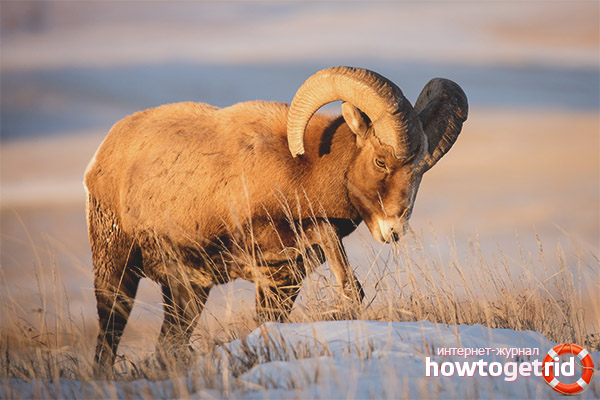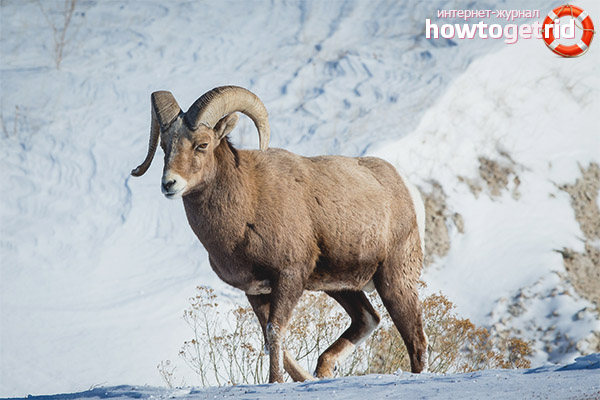The content of the article
It is nice to realize that there is a lot of beauty on our planet. For example, a beautiful bighorn sheep, or rhino, lives in the mountains. This animal looks very beautiful, especially against the backdrop of snowy landscapes.
View description
Snow sheep belongs to the family of bovids. An animal is a cloven-hoofed ruminant. His physique is quite large, knocked down, muscular. The structure of the body is vaguely reminiscent of the structure of mountain goats, since they also live in mountainous areas and are forced to move around the territory of high mountain ranges. The body length in males reaches up to 170 cm, in females - up to about 150. The maximum weight of an adult male can reach 150 kg, and this is at a time when there is a lot of food in the meadows.
In comparison with the body, the head is small, has a wedge-shaped muzzle. Eyes are small, ears are neat and pointed. The cervical region is shortened. Thick and short limbs.
Gorgeous horns - long and spiral-shaped, adorn the male animal. Their diameter at the base is 35 cm, and at the end they are sharp, turned outward. Females have much more modest horns.
The ram’s body protects the thick white fur from frost. On the back, it acquires a milky hue, and on the sides it turns into a dark brown color. When it’s warm, the snow sheep’s hair is short, but with the advent of autumn, a change in the coat begins, the upper parts of the remaining hairs break off, the spinous undercoat and more fluffy hairs begin to appear. They have a slightly lighter color, which will make the animals invisible against the background of snow.
Bighorn sheep have features during molting. Initially, this process begins in young individuals, then the turn comes for spring males and females. After the cold weather, molting occurs in the first part of May and can last until the end of June. But, if the female has offspring, then the change of coat can drag on until August.
The hairline always starts to update in the abdomen and sides. The coat on the limbs changes last. When the first month of winter comes, the change takes place completely.
There are varieties of these sheep, which include:
- Putoransky - was included in the Red Book due to the fact that there is a danger of the destruction of this species;
- Yakut;
- Okhotsk;
- Koryak and others
Habitat
The most common habitats of this species of bovids are Siberia and Chukotka, Kamchatka and Sakhalin. It is believed that more snow sheep live in Yakutia. But they do not live everywhere, but only in those places where there are rocks. There it is easier to escape from all kinds of predators. The habitat of animals is mid- and alpine regions, less often - plateaus.
Bighorn sheep are always in the same habitat zone, and rarely leave it, only if hunger forces them to seek food. Very small movements associated with the change of season are noted. When the weather is raging, the ram hides in various shelters, and most often it is either a cave or a rock niche. It is warm due to the fact that a kind of litter, consisting of fur and dried litter, gradually accumulates under the animal.
Life among the snows

These animals are active during the day.But, when the time comes for bright nights, some representatives can graze at a later time. All day they are on the road in search of food. If the weather is too hot, the ram can afford to rest several times during the day.
How long each meal lasts, and what the gap between them depends entirely on factors such as weather conditions, availability and abundance of food, as well as the presence of blood-sucking insects.
When it is necessary to rest, the hornbill creates comfortable conditions for itself, which consist in the fact that a recess in the ground is trampled by hoofs. Usually a place is selected only in the area where the terrain is open, and no predator can suddenly get close and attack. This may be the top of the gorge or spine saddle.
In search of food, the ram goes to mountain gorges, especially if there are rivers or streams there. But very often they try not to leave the hill, and if there is a possible danger, they are saved, cleverly climbing the hill.
Nutrition
Spending time almost constantly chewing food, the sheep eats a lot of feed. The chewing apparatus helps him in this, which helps to grind not only fresh vegetation, but even adapted to process thorns, no less prickly spikelets. The snow sheep’s intestines are so long that they are 30 times larger than the body itself, which is why it does not suffer from eating large amounts of food.
The animal eats almost all the vegetation on the ground that it encounters, including succulent grasses, mushrooms and lichen, which exists even on bare rocks. But all this abundance happens in the summer season. When autumn comes, various berries appear on the menu. In winter, the ram has a harder time, but under the snow cover it finds dried grass, moss, rhizomes, fallen berries and thorns, and lichen. They dig up snow with the help of front hooves. Unfortunately, until young greens appear, many animals are so exhausted that they die, unable to bear the constant feeling of hunger.
Collective coexistence
In summer, adults live together, uniting in small herds, in which there are up to 6 sheep. There are both males and females. Some males, especially the oldest, prefer to live completely apart. But when autumn comes, the bogs combine to form a whole herd, numbering up to 50 individuals. The young generation, and the lamb of this and last year’s birth belong to it, have not yet left their mother, so puberty comes to this species late - on the 3rd year of life.
This is the most favorable time, since the blood-sucking parasites have already disappeared, there are a lot of vegetation. But this period quickly ends with the onset of frost. And then the herd breaks up into small groups. Already in October, heavy snowfalls are observed, and sheep move into the forest zone. But still, this place should be located at the rocks, which are a reliable shelter for these animals.
Breeding

Here, at the upper border of the forest, a race begins. This time usually falls on November or December days. About 5 - 6 females appear about three applicants.
Events are developing dramatically. Adult experienced males who are already 5 years old, all young ruthlessly expelled. And themselves, when the marriage time has passed, they remain with the group for some time, leaving in January. During the rut, there are small clashes between the suitors, which are accompanied by clashes of horns. Then the rivals disperse. The winner usually leaves the loser alone, but it happens that during this period the males die from their counterparts.
Lambs appear just when there is a lot of vegetation and heat in June. Two weeks before giving birth, the expectant mother retires, finds a convenient and secluded place, away from predators. More often one cub is born, and very rarely two.
Kids adapt to living conditions very quickly. Only a few days will pass, and they will already be able to overcome small rocky surfaces. They get breast milk from their mother for only one month, and then they switch to adult food. If at birth the lamb weighs no more than 5 kg, then by the time frost comes, it is already about 25 kg. At birth, the lambs are completely “equipped”: they have gray shade, a dark strap is observed along the ridge, and a bright spot in the form of an asterisk appears on the forehead.
In the early days, the thick-toddler kids already know that in moments of danger you need to lie low, and after a few days they always remember that you can not keep up with your mother, and follow her on the heels. And she will always protect them.
The puberty of females occurs in two years, and in a year they can reproduce offspring only once.
Video: Snow Ram (Ovis nivicola)










Submit